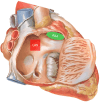Short-term effect of low atrial septum pacing on new-onset atrial fibrillation in patients with sinus node dysfunction a prospective randomized single-center study
- PMID: 40852001
- PMCID: PMC12369769
- DOI: 10.1097/MS9.0000000000003362
Short-term effect of low atrial septum pacing on new-onset atrial fibrillation in patients with sinus node dysfunction a prospective randomized single-center study
Abstract
Background: Patients with sinus node dysfunction (SND) are at risk of atrial fibrillation (AF) after dual-chamber pacemaker implantation. AF is a risk factor for cardiovascular and cerebrovascular events. The location of atrial electrodes can influence AF occurrence. This study aimed to investigate the differences in the incidence of new-onset AF between low atrial septal (LAS) and right atrial appendage (RAA) pacing in patients with SND and explore the possible underlying mechanisms.
Materials and methods: We included 155 patients with SND, including 83 and 72 who received LAS and RAA pacing, respectively. We collected baseline data, electrocardiogram indexes, and ultrasound cardiogram indexes, as well as postoperative complications, program testing data of the pacemaker, electrocardiogram indexes, and AF occurrence during 1-year follow-up.
Results: The operative duration was significantly longer in the LAS group than in the RAA group (P < 0.001). The intraoperative P-wave amplitude was significantly smaller in the LAS group than in the RAA group (P =0.001). The P-wave duration and cumulative percentages of ventricular pacing (Cum % VP) in the LAS group were significantly lower than those in the RAA group (P < 0.001 and P =0.039, respectively). At 1-year follow-up, the incidence of new-onset AF was significantly lower in the LAS group than in the RAA group (16.9% vs. 36.1%, hazard ratio [HR]: 0.363, 95% confidence interval [CI]: 0.156-0.846, P = 0.019). The independent risk factors for new-onset AF at 1-year follow-up were combined bundle branch block (odds ratio [OR] 8.015, 95% CI 1.232-52.132, P = 0.029), large left atrium (OR 5.812, 95% CI 1.202-28.088, P= 0.029), and prolonged postoperative P-wave duration (OR 1.027, 95% CI 1.009-1.045, P = 0.018). LAS pacing was associated with a reduced risk of postoperative AF occurrence (OR 0.072, 95% CI 0.010-0.542, P = 0.011).
Conclusion: For patients with SND after dual-chamber pacemaker implantation, AF incidence within 1 year after LAS pacing was significantly lower than that after RAA pacing. LAS pacing could shorten the postoperative P-wave duration, an independent risk factor for new-onset AF, and LAS pacing effectively reduced the Cum % VP, which may be the underlying mechanism by which LAS pacing prevents postoperative AF occurrence.
Keywords: P-wave duration; atrial fibrillation; low atrial septal pacing; right atrial appendage pacing; sinus node dysfunction.
Copyright © 2025 The Author(s). Published by Wolters Kluwer Health, Inc.
Conflict of interest statement
The authors declare that the research was conducted in the absence of any commercial or financial relationships that could be construed as a potential conflict of interest.
Figures





Similar articles
-
Impact of ventricular pacing modalities and pacing percentage on new-onset atrial fibrillation after dual-chamber pacemaker implantation.Front Cardiovasc Med. 2025 Jun 19;12:1615420. doi: 10.3389/fcvm.2025.1615420. eCollection 2025. Front Cardiovasc Med. 2025. PMID: 40612374 Free PMC article.
-
Intravenous magnesium sulphate and sotalol for prevention of atrial fibrillation after coronary artery bypass surgery: a systematic review and economic evaluation.Health Technol Assess. 2008 Jun;12(28):iii-iv, ix-95. doi: 10.3310/hta12280. Health Technol Assess. 2008. PMID: 18547499
-
Dual-chamber pacemakers for treating symptomatic bradycardia due to sick sinus syndrome without atrioventricular block: a systematic review and economic evaluation.Health Technol Assess. 2015 Aug;19(65):1-210. doi: 10.3310/hta19650. Health Technol Assess. 2015. PMID: 26293406 Free PMC article.
-
External electrical and pharmacological cardioversion for atrial fibrillation, atrial flutter or atrial tachycardias: a network meta-analysis.Cochrane Database Syst Rev. 2024 Jun 3;6(6):CD013255. doi: 10.1002/14651858.CD013255.pub2. Cochrane Database Syst Rev. 2024. PMID: 38828867 Free PMC article.
-
Prescription of Controlled Substances: Benefits and Risks.2025 Jul 6. In: StatPearls [Internet]. Treasure Island (FL): StatPearls Publishing; 2025 Jan–. 2025 Jul 6. In: StatPearls [Internet]. Treasure Island (FL): StatPearls Publishing; 2025 Jan–. PMID: 30726003 Free Books & Documents.
References
-
- Sathnur N, Ebin E, Benditt DG. Sinus node dysfunction. Card Electrophysiol Clin 2023;41:349–67. - PubMed
-
- Duan S, Du J. Sinus node dysfunction and atrial fibrillation – relationships, clinical phenotypes, new mechanisms, and treatment approaches. Ageing Res Rev 2023;86:101890. - PubMed
-
- John RM, Kumar S. Sinus node and atrial arrhythmias. Circulation 2016;133:1892–900. - PubMed
-
- Chang W, Li G. Clinical review of sick sinus syndrome and atrial fibrillation. Herz 2022;47:244–50. - PubMed
LinkOut - more resources
Full Text Sources
